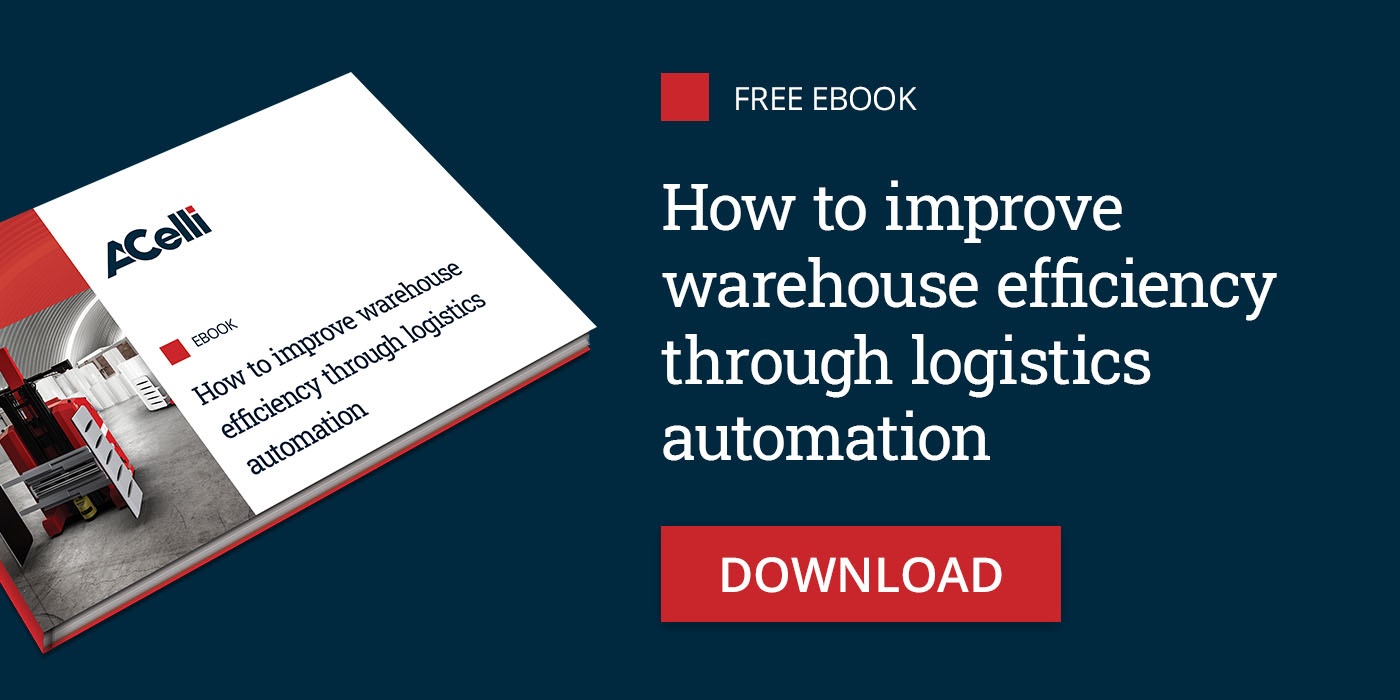[UPDATED ON MAY 2022]
If you want to succeed in the age of "Logistics 4.0", it is vital to know how to manage an automated warehouse system.
This new era has led to such advances as: a reliance on vehicles and robots to move and handle goods (e.g. the use of AGVs, automated guided vehicles), to sensors, to connectivity with the Internet of Things, and to advanced computer systems with management software and data analysis.
Even if a warehouse remains sort of "behind the scenes", it should not be regarded as just a space to park goods, in other words, as a non-strategic part of the whole system. Ignoring warehouse management will inevitably lead to inefficiency in the sales and distribution chain at some later date.
This article aims to explain how to manage an automated warehouse system in the simplest possible way, starting with the basic rules you may know already, and proceeding to others you might not yet have considered. Some of the management practices from the past are still valid, but advances in technology have led to new challenges and opportunities.
Even in the Logistics 4.0 era, we still need to avoid stock wastage and shortage, to ensure punctual delivery, to contain expenses, and to respect quality standards and regulations. What has changed today is the tools we use for everyday operations: mechanical means are combined with electronics, and the work of man with the work of machines. The way of managing resources has also changed, and this includes all collaborators, equipment, goods, and finally, data.
Indeed, in relation to data, the key lies in the concept of integrating the automated warehouse with upstream and downstream systems.
Automated warehouse system management, step by step
Let's examine the factors involved in the successful management of an automated warehouse: a context involving much more than may first appear.
In developing your strategy, you will need to consider physical aspects such as storage space, goods and tools, but also such factors as human resources and technological systems, and intangible assets, such as software and data.
1. OrganisE the space
There are many variables to consider when organising space in a warehouse: product bulk, production flow and timing, demand, perishability, and many other factors.
Nothing new so far. However, it is now possible to greatly increase storage capacity within the same area by using vertical warehouses. With this arrangement, everything still remains "within reach" thanks to the use of automated pallet storage systems such as stacker cranes, which can access heights totally impossible for warehouse workers.
This type of layout is more efficient and one of the more interesting warehousing practices to increase storage space (and so can reduce energy and rental costs), but it also requires some careful planning. It might be a good idea to set aside the floor level for your best-selling products and those with most frequent input/output; or you could arrange your goods in columns (each consisting of the same product, which can therefore be taken from either a low or high shelf). In addition, keeping a physical inventory at floor level of all the goods in store helps to speed up checks on product details.
2. ChoosE the right physical tools
There is now a huge range of equipment for goods handling, including forklifts, AGVs (automated guided vehicles, self-driving vehicles that move and pick up goods), roller conveyors and mobile shelving.
This may seem prosaic, but it's not; as well as choosing the right equipment for your needs, you will also have to work out how many machines you actually require. How do you do that? It might be helpful to divide the warehouse into sections and allocate a certain number of resources to each one.
You will also need to assess the productivity of these machines, calculating the volume of goods they can process within a certain time, and the maximum number of working hours they can do every day, week or month.
If necessary, look at "24/7" equipment, such as some types of AGV, and consider which processes could be done at night to avoid interfering with other work. Another time-saving solution is the use of handling systems that act as automatic sorting devices (anthropomorphic robots, sorters, etc.)
You might also consider labelling, reading and recognition systems for products, including radio frequency scanners, RFID tags, and the latest voice command systems, which allow you to work hands-free.
These solutions reduce both the time needed for operations and margin of error, because during the shipping phase, for example, there is no risk of one product being confused with another. Another advantage is that one can acquire all necessary data in digital form, and so store it permanently and analyse it fast and precisely.
3. Choose the right “intangible” tools
If machines are the "workers" in an automatic warehouse, then computers and apps are the "managers". A warehouse management system (WMS) oversees processes, goods and information. It monitors incoming and outgoing items; prepares orders and shipments; plans activities to be carried out at specific times of the day, week or month; records stock handling and picking, goods receiving, stock rotation, stock levels, and much more. The staff in charge of operations can access these data via a dashboard. To provide an overview, this software can be integrated with ERP and CRM systems.
More specific forms of software will forecast requirements with regard to production and supply. Material Requirements Planning software helps one to plan activities such as production and the use of machinery and human resources, as well as conducting market analysis.
Other programmes take charge of inventories: they can track thousands of articles, warn when stocks are low and restocking is required, or conversely, suggest limiting stock levels. Tools of this type help you save on unnecessary costs, improve customer service (avoiding stock shortages and delayed deliveries), and keep control on goods handling and resources in the warehouse.
4. Find out what Is not working (and use the data to improve)
The 4.0 tools make it much easier to identify inefficiencies and errors in strategy: with every item and process recorded in digital form, you can achieve levels of visibility and control that would normally be unthinkable.
Also, the larger and more varied the business, the greater the complexity, and the more vital the monitoring and data analytics systems become.
- Did you produce more goods than you could sell?
- Is stock rotation too slow?
- Does stock-checking take too long?
- Have you had problems with stock shortages and outstanding orders?
- Is the flow of goods at optimum levels?
By analysing the data collected by sensors, RFID tags, AGVs and other systems, you will get answers to these questions. Once you identify the problems in your workflow, you can take action by - for example - increasing or decreasing production, updating your inventory, assigning more or fewer machines or workers to a certain department, and so on.
In particularly complex situations, the use of machine learning software can make a significant difference, analysing logistic data to produce suggestions on possible improvements.
The principles of automated warehouse management
The good management practices used in traditional warehouses remain valid, but they must adapt to the processes resulting from the "4.0 revolution". On the one hand, it can’t be denied that work becomes more complex as a result of automation. We have to learn to manage data as well as physical goods, and to make use of machines in addition to human labour. On the other hand, once the system is up and working, it becomes much easier to keep control of operations and to identify any problems.
In summary: the proper management of an automated warehouse system requires you to follow three basic principles:
- Optimisation of resources, in terms of space, energy consumption, lead times and investments in technological upgrades, with a proven ROI;
- Control: maintaining an overview of production and data, but also a detailed and analytical perspective, helping you to understand problems and identify areas for improvement;
- Integration between people and technologies, between tangible and intangible tools, and between goods and data.
We have explained how to manage an automated warehouse, but is yours still a long way from using robots and data analysis software?
You can start by reading our free eBook, which explains how to improve warehouse efficiency through logistics automation.

